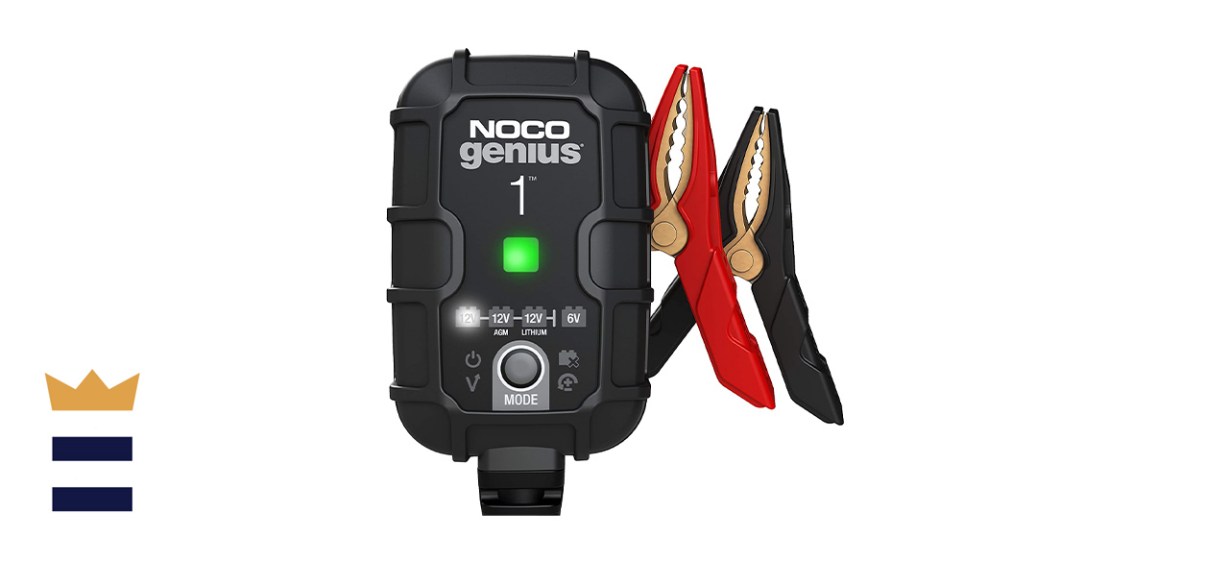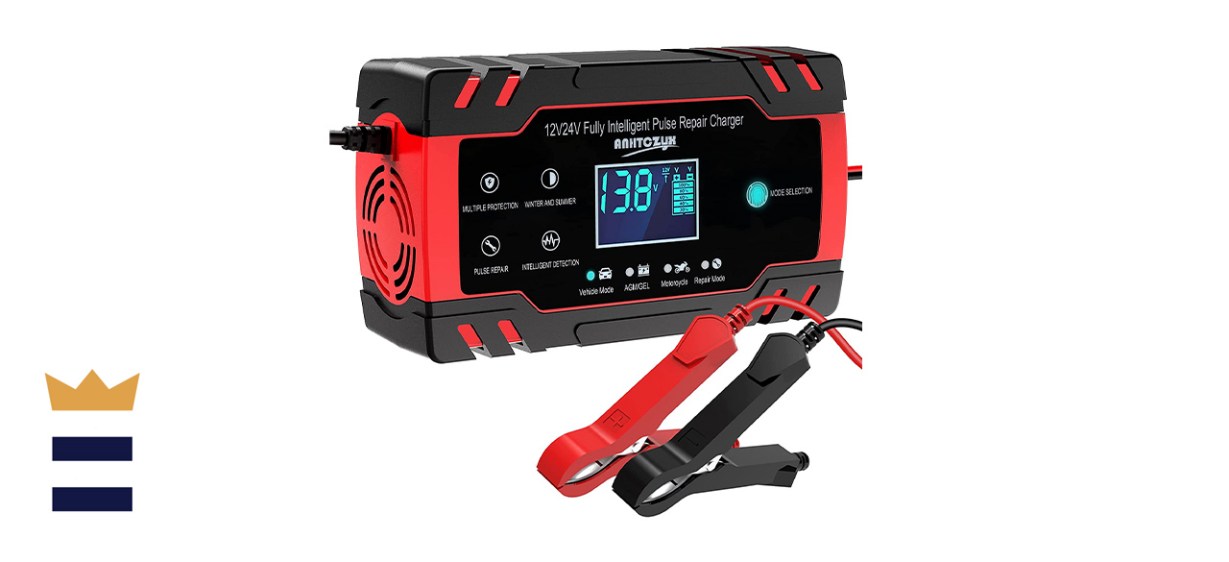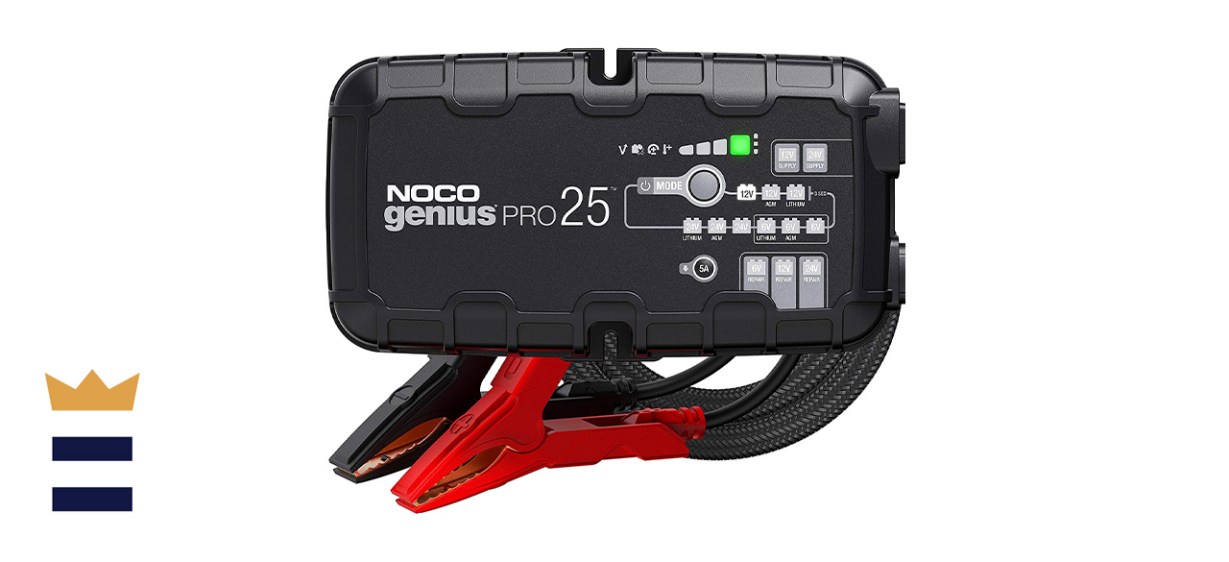Which trickle charger is best?
A dead battery can put a real damper on your day. When it’s finally time to remove the cover on your winter-stored vehicle and take it out for a spin, the last thing you want is to find that it doesn’t start. If you plan on putting your vehicle or any batteries away for long periods, you’ll need a trickle charger.
These convenient, portable devices ensure that your battery never runs out of juice. For most vehicles and batteries, the best trickle charger is the Noco Genius1 Automatic Smart Charger.
What to know before you buy a trickle charger
What is a trickle charger?
A trickle charger is a portable device that slowly charges a lead-acid battery. Designed to do so slowly, these tools are best used for maintenance. They combat a battery’s natural degradation by slowly pouring on the amperage, which cancels out the battery’s discharge rate.
Trickle chargers consist of a positive and negative line feeding out of the meter box. These connect to your car and battery with alligator clips. The charger will have a power cord that plugs into your wall.
How to use a trickle charger
Trickle chargers are designed to be left charging for long periods of time. This means you won’t have much luck using them to jump-start your car. Instead, they’re best used for storing batteries or vehicles long term.
When using a trickle charger, make sure your voltage and amperage are correct for the battery before hooking anything up. The last step should be plugging in your charger to the wall.
Before connecting the positive terminal to your battery, you need to locate sufficient ground to attach the negative clamp. This can be any bare metal in your car such as the frame, a chassis bolt or the engine block. Then attach the positive clamp to your battery’s positive terminal. Plug your charger in and standby to ensure that your battery begins charging (and is not completely dead).
Important cautions when using a trickle charger
- Overcharging: Not all trickle chargers are overcharge proof. Charging a battery past its capacity can fry it. If your trickle charger doesn’t have a cutoff, you’ll need to monitor your battery’s voltage.
- Ventilation: It’s important to make sure you’re charging in a well-ventilated space. The battery’s terminals release hydrogen and oxygen during the process, which can be an explosive mixture. So pop the hood, open a window and make sure you air the room out properly before disconnecting the clamps.
- Shock risk: Never touch the wires, clamps or terminals while the trickle charger is on and recharging your battery as you could electrocute yourself.
What to look for in a quality trickle charger
Voltage
Car batteries are typically six volts or 12 volts. Your trickle charger’s voltage rating should match your car battery’s voltage to guarantee a proper charge. A higher-rated charger can overcharge your battery or decrease its life span. An underrated charger will actually reverse the effect, becoming a sink and draining your battery.
Amperage
Amperage describes how much power your battery has available to distribute. Trickle chargers let out a steady, low stream of electricity — about two amps. This is just enough to combat the natural loss of your battery if it’s outside of your vehicle. It also offsets the parasitic draw of your vehicle’s electronics, which require milliamps to stay working while your car is running. Without removing the battery, leaving your car sitting for 1-2 weeks is enough for these electronics to drain your battery to the point where your car won’t start.
Float mode
Trickle chargers with float modes can monitor your battery’s voltage and shut themselves off when a certain threshold is met. This is called float mode. When the battery dips down below the correct voltage, the charger will turn back on to offset the natural decay. Float mode is an important feature if you want to charge your batteries without worrying about overcharging, or making frequent check-ins.
How much you can expect to spend on a trickle charger
Trickle chargers cost $30-$120, with premium, heavy-duty models going all the way up to $550.
Trickle charger FAQ
Do trickle chargers only work on car batteries?
A. Trickle chargers work on all kinds of lead-acid batteries from golf carts and motorcycles to boats and other watercraft. You just need to verify the voltage rating so as to prevent overcharging or draining.
Can I use a trickle charger to jump-start my car?
A. Trickle chargers work slowly — too slowly, in fact, to restore your car’s charge in a pinch. If you’ve just dropped below the voltage threshold because you left your lights on in the parking lot, you might be able to get the battery back to where you can start the car in an hour or two. But you’ll want a standard charger or jumper cables for a reliable, quick boost.
What’s the best trickle charger to buy?
Top trickle charger
Noco Genius1 Automatic Smart Charger
What you need to know: With AGM and lithium-battery compatibility, this trickle charger has just about every vehicle covered.
What you’ll love: Small and portable with a simple interface, Noco’s Genuis1 can bring batteries as low as 1 volt back to life. Its smart technology not only monitors and adjusts for voltage but also ambient room temperature. The small charging box plugs directly into your wall so you don’t have to worry about taking up space or tripping on wires.
What you should consider: This charger isn’t rated for 24-volt batteries and only has a 1-amp current.
Where to buy: Sold by Amazon
Top trickle charger for the money
What you need to know: This budget trickle charger is perfect for boat, truck and RV owners.
What you’ll love: Rated for 12- and 14-volt batteries, the Yonhan has a float mode to ensure you never overcharge your batteries. It features a graphic display for easy monitoring. The desulfation mode can even restore some batteries that succumb to sulfuric acid buildup after being left out too long. This charger also has a summer and winter mode to broadly adjust for ambient temperature.
What you should consider: Some users felt that the construction was a little flimsy and worried about longevity.
Where to buy: Sold by Amazon
Worth checking out
What you need to know: This is the hardcore, professional model trickle charger for anyone facing extreme temperatures or maintaining fleets of different vehicles.
What you’ll love: The GeniusPro25 features all of the same controls as the standard Noco charger from float mode to ambient temperature monitoring. What sets it apart is its six-, 12- and 24-volt capacity for all battery types. This means the GeniusPro is a one-stop shop for any battery you can imagine. It even swaps over to DC power on the 12- and 24-volt spectrum to power devices or store battery memory during swaps. The set comes with multiple cords and power cables, as well as a hardshell carrying case.
What you should consider: For all of these features, you’re looking at one of the most expensive trickle chargers on the market.
Where to buy: Sold by Amazon
Sign up here to receive the BestReviews weekly newsletter for useful advice on new products and noteworthy deals.
Karl Daum writes for BestReviews. BestReviews has helped millions of consumers simplify their purchasing decisions, saving them time and money.
Copyright 2022 BestReviews, a Nexstar company. All rights reserved.




















